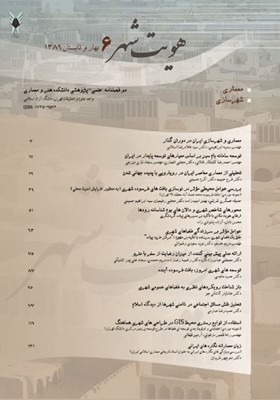توسعه های شهری امروز، بافت های فرسوده آینده
محورهای موضوعی : معماری
1 - استاد شهرسازی، دانشکده هنر و معماری، واحد علوم و تحقیقات، دانشگاه آزاد اسلامی
کلید واژه: Urban development, توسعه شهری, بافت تاریخی, بافت فرسوده, بافت شهری, urban context, historic context, deteriorated context,
چکیده مقاله :
بافت های تاریخی امروز، بخشی از بافت شهرهای کشور به یادگار مانده از یک یا دو قرن گذشته و حتی نیمه اول قرن حاضر می باشند که اکثر آن ها علی رغم واجد ارزش بودن از نظر تاریخی - فرهنگی به فرسودگی گرائیده اند. ولیکن همواره ضرورت حفظ، احترام و بازآفرینی ارزش ها در این گونه بافت ها مورد توجه معماران، برنامه ریزان و طراحان شهری بوده است و به تأثیر ساختارهای اجتماعی، فرهنگی، سیاسی و اقتصادی بر توسعه بافت های مذکور توجه گردیده و توسعه در بافت های تاریخی با رویکرد حفظ ارزش های کالبدی- فضائی مد نظر قرار گرفته است. گذشت زمان ما را به شناخت توسعه جدید شهرها به عنوان بافت های تاریخی و حتی فرسوده نزدیک می کند و در آینده برنامه ها و طرح های توسعه شهری، جزئی از بافت های فرسوده محسوب خواهند شد. هدف از ارائه این مقاله بررسی توسعه های شهری جدید که به احتمال بسیار زیاد، در آینده بافت فرسوده محسوب خواهند گردید، می باشد (ماجدی، 1389).
Urban contexts are solely created depend on the development extent of the country, worldwide and for every eras. In other word, politic, economic, social, as well as cultural conditions were of vital components in formation of urban contexts every time. Nowadays, historic contexts are part of cities survived from the two past decades or event last of the present era. Despite of being highly qualified, most of them have been deteriorated in view of historic or cultural. However, essential consideration for conservation, respect, as well as renovation of such contexts was amongst the programs of architecture, planning, as well as urban design engineers. In this regard, the effect of social and cultural structures along with politic and economic structures was of remarkable focus. Development in historic contexts has been attentively studied to preserve the space-structure values. Pass of time make the human beings more close to the identification of new development of cities in the past decades as the historic or probably much deteriorated contexts. In a very close future, urban development plans, performed or under construction, would be considered as a part of old contexts and remarkable studies will be carried out around these subjects. This study aims to investigate the modern urban development which high probably would be among the deteriorated contexts within next few years. In case of acceptance of some few components of “ skeleton structure” including “small plot”; “impermeability”; “instability” approved by Excellent Council of Urbanization and Architecture along with “economic structure” and “social structure”, paying attention to the deficiencies of “urbanization in country” would be of vital importance. The considerable deficiencies include content, procedure, investigation, as well as approval and performance of urban development plans. Such deficiencies may result in “small plot”; “impermeability” in urban context. Moreover, this study investigates the problems in “building control” (such as issue of certification for construction permit, building completion and no offence) which lead to appearance of “instability” in buildings throughout the urban context and eventually the whole “urbanization and architecture” complex. Totally, such problems may interfere in make an unsuitable environment for citizens or the economic and social decline of urban identity. Overall, the objective of this study is to save the new contexts of being deteriorated in future. This study had a concise view on the effects of politic, social and economic structures of today life on the under construction contexts high probably considered as deteriorated ones. Preparation of urban development plans ignoring social, economic, as well as skeletal structure of deteriorated contexts and essential measures towards promotion and innovation, totally separated from the urban development plans, not only could not be succeeded in fixing the related problems but also create more complicated ones in this regard.Experiences of these comprehensive plans during recent decades demonstrated that any delay in providing proper plan for deteriorated contexts would extend the related problems more and more
- ماجدی، حمید، (1389). «بافت های فرسوده شهری آینده»، دومین همایش ملی بهسازی و بازآفرینی بافتهای تاریخی، فرسوده شهری و سکونتگاههای غیر رسمی. سازمان عمران و بهسازی شهری، وزارت مسکن و شهرسازی.
2- شورای عالی شهرسازی و معماری ایران، مصوبات سال 1386.
3- جباری،حبیب و حسن زاده، داوود، (1387). «مداخله در بافتهای فرسوده شهری و چالشهای پیش رو»، مقاله ارائه شده در اولین همایش بافتهای فرسوده شهری، سازمان عمران و بهسازی شهری، وزارت مسکن و شهرسازی، مشهد.
4- ماجدی، حمید و دیگران، (1378).«مبانی و چارچوب بازنگری شرح خدمات طرحهای شهری»، وزارت مسکن و شهرسازی.
5- ماجدی، حمید، (1382). «شهرسازی معاصر ایران: تحول در قوانین، ساختارها و روشهای شهرسازی در چهار دهه گذشته و چشمانداز آینده»، آبادی، فصلنامه شهرسازی و معماری، سال سیزدهم، شماره 40 و 41، شماره پنجم و ششم دوره جدید.
6- ماجدی، حمید، (1382). «برنامهریزی راهبردی راه حلی برای رفع مشکلات شهری»، فصلنامه شهرساز، شماره 2.
_||_

